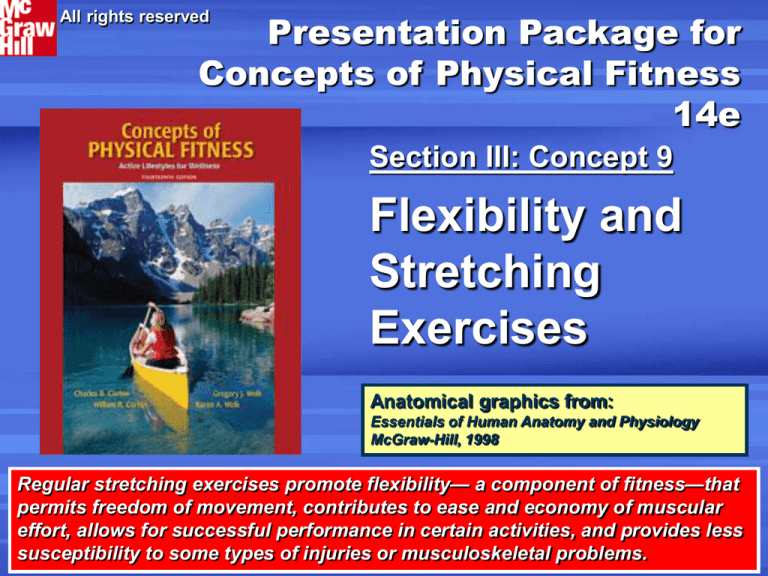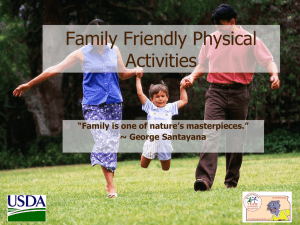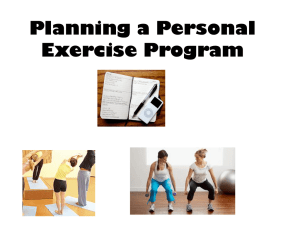
Presentation Package for
Concepts of Physical Fitness
14e
All rights reserved
Section III: Concept 9
Flexibility and
Stretching
Exercises
Anatomical graphics from:
Essentials of Human Anatomy and Physiology
McGraw-Hill, 1998
Regular stretching exercises promote flexibility— a component of fitness—that
permits freedom of movement, contributes to ease and economy of muscular
effort, allows for successful performance in certain activities, and provides less
susceptibility to some types of injuries or musculoskeletal problems.
Flexibility Activity
• Flexibility is an
important, but
often neglected
part of an exercise
program.
• The importance of
flexibility for
health and wellbeing becomes
more important
with age.
2
Concepts of Physical Fitness 14e
Flexibility Fundamentals
• Not the same as stretching.
• The range of motion in a joint or joints is
used to reflect flexibility at that joint.
– ROM= the extent and direction of
movement that is possible.
– Joint specific
• Specific vocabulary is used to describe
the movement of joints.
– Flexion/extension, abduction/adduction,
internal and external rotation, etc.
3
(see next slide)
Concepts of Physical Fitness 14e
Common Movements
•
•
•
•
•
4
Flexion
Extension
Abduction
Adduction
Rotation
Concepts of Physical Fitness 14e
Flexibility Fundamentals
continued
• The unique nature of the different
joints causes some to allow for greater
mobility than others.
– Ball-and-socket joint
– Hinge joint
• ROM at a joint depends on how it is
being assessed
– Static = without movement
– Dynamic = active functional activity
5
Concepts of Physical Fitness 14e
Factors Influencing
Anatomy
Flexibility
•
– Long “muscle-tendon units” (MTUs)
– Properties of connective tissue and muscle
– Type of joint
• Gender
– Females more flexible
6
• Possibly related to:
– bone structure (e.g., wider hips)
– hormonal influences
– physical activity choices (e.g., dance,
gymnastics, swimming) that require good
flexibility Concepts of Physical Fitness 14e
Factors Influencing
Flexibility continued
• Genetics (loose joints)
• Lack of use or misuse
– Lack of physical activity / muscle
imbalances
• Race
• Age (see next slide)
7
Concepts of Physical Fitness 14e
Influence of Age on
Flexibility
F
L
E
X
I
B
I
L
I
T
Y
A
C
T
I
V
I
T
Y
FLEXIBILITY
PHYSICAL ACTIVITY
10
20
30
40
50
AGE (years)
8
Concepts of Physical Fitness 14e
60
70
Health Benefits of Flexibility
• No ideal standard for flexibility exists.
• Necessary for optimal posture.
• Extremes of inflexibility and
hyperflexibility increase the likelihood of
injury.
• May help prevent muscle strain and such
orthopedic problems as back pain (see
next 2 slides).
• Stretching may help to relieve muscle
cramps, stiffness, and some local or
referred pain.
9
Concepts of Physical Fitness 14e
Flexibility & Back Pain
• Short and tight
muscles cause
poor posture
which leads to
back pain.
10
Concepts of Physical Fitness 14e
Flexibility & Back Pain
11
Concepts of Physical Fitness 14e
Long and strong
muscles keep
the body in
good alignment
and reduce risk
of back pain.
Health Benefits of
Flexibility
• Stretching is probably ineffective in
preventing muscle soreness.
• Overstretching may make a person
susceptible to injury or hamper
performance.
• Freedom of movement
• Improved athletic performance
– Questionable benefits prior to
competition
12
Concepts of Physical Fitness 14e
Stretching Methods
• Static
–Active assistance
–Passive assistance
• Ballistic
• PNF
13
Concepts of Physical Fitness 14e
Static Stretching
•
•
•
•
•
Safer and less likely to cause injury
Stretch slowly until tension
Hold stretch for 10 - 30 sec.
Relax the muscle
Increase stretch a bit more
(developmental stretch)
14
Concepts of Physical Fitness 14e
Static Stretching
• Active stretching
• Passive stretching
See next slide (Figure 3)
15
Concepts of Physical Fitness 14e
16
Concepts of Physical Fitness 14e
Ballistic Stretching
• Dynamic movement
• Specificity of movement
17
Concepts of Physical Fitness 14e
Proprioceptive
Neuromuscular Facilitation
(PNF)
• Combines (active and passive)
methods
• Most effective method for
improving flexibility
• Promotes increase in strength
18
Concepts of Physical Fitness 14e
PNF Stretching
Technique
(C.R.A.C. Method)
•
•
•
•
Contract agonist isometrically
Relax muscle for a few seconds
Contract the antagonist for 15 seconds
Relax
Web09-02
19
Concepts of Physical Fitness 14e
How Much Flexibility
is Enough?
How Much Stretching
is Enough?
20
Concepts of Physical Fitness 14e
How much is enough?
• Stretching exercises should be done
regularly to achieve optimal benefits.
• For flexibility to be increased, you must
stretch and hold muscles beyond normal
length for an adequate amount of time.
(see the stretch reflex on the next slide)
• Performing warm-up exercises is not the
same as doing a stretching workout for
flexibility development.
• The best time for stretching is when the
muscles are warm.
21
Concepts of Physical Fitness 14e
Stretch
Reflex
22
Maintaining
stretch for
10- 30
seconds
will allow
the
stretch
reflex
to subside
and
permit
gains.
Concepts of Physical Fitness 14e
FIT Formula
(Static Stretching)
F
I
T
3 - 7 times per week
10% beyond normal length of muscle
15-60 seconds, 3-5 reps
(rest 30 sec between reps)
23
Concepts of Physical Fitness 14e
Flexibility-Based Activities
• Yoga
• Tai Chi
• Pilates
24
Concepts of Physical Fitness 14e
Stretching Aids /
Technology
•Stretching ropes
can make it easier
to execute and hold
stretches properly.
•Foam rollers can
improve strength,
balance, and
flexibility.
25
Concepts of Physical Fitness 14e
Guidelines for Safe &
Effective Stretching Exercise
• Do not force the stretch to the point
of pain.
• Choose safe exercises.
• Avoid overstretching weak muscles.
• Use good technique.
See samples of
good stretching
technique
26
Concepts of Physical Fitness 14e
Summary
•
•
•
•
•
Flexibility is the often neglected
Joint specific
Many influencing factors
Many health benefits
Static stretching is the most
widely recommended.
• 3-7 days per week target
27
Concepts of Physical Fitness 14e
Web Resources
Online Learning Center
“On the Web” pages for Concept
28
Concepts of Physical Fitness 14e
Supplemental
Graphics
Lab Information
Lab 9a Information
Evaluating Flexibility
• Make sure that you are warmed up prior to
testing.
• Follow the instructions as close as possible
since the best use of the results is to compare
scores over time.
• Perform each of the stretches in the lab
(Be sure to check left and right separately).
• Complete ratings and then evaluate your
personal flexibility needs according to your
results.
30
Concepts of Physical Fitness 14e
Areas Needing
Stretching
•
•
•
•
•
•
31
Hamstrings
Inner thigh
Calf
Hip flexors
Lower back
Chest / shoulders
In Lab 9b, you can
plan a stretching
program to address
your personal needs.
Concepts of Physical Fitness 14e
Lab9b Information
Planning and Logging
Stretching Activity
• Set goals for doing specific
stretches during the week.
• Monitor progress using logging
charts.
32
Concepts of Physical Fitness 14e
Hamstring Stretches
BAD
Standing
Toe Touch
33
BAD
Bar Stretch
GOOD
Back Saver Hamstring
Stretch
Concepts of Physical Fitness 14e
Return to
presentation
Shin & Quadriceps
Stretches
BAD
34
Standing Stretch
GOOD
GOOD
Shin Stretch
Quad Stretch
Concepts of Physical Fitness 14e







